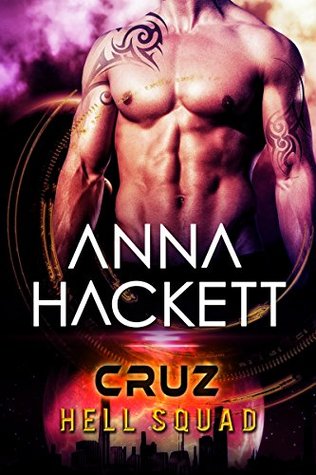 Cruz (Hell Squad #2)
Cruz (Hell Squad #2) by
Anna Hackett Formats available: ebook, paperback
Series: Hell Squad #2 Pages: 244
Published by Anna Hackett on August 10th 2015
Purchasing Info: Author's Website,
Amazon,
Barnes & Noble,
Bookshop.org Goodreads Battle-hardened soldier Cruz Ramos is running on empty. As second-in-command of the deadliest commando squad fighting the invading aliens, he doesn't know why he's fighting anymore. He's seen too much destruction, devastation, and far too much death. Still, every day he goes out to protect those humans left, and every day the growing numbness threatens to take over. Until a mysterious woman emerges from the ruins of destroyed Sydney and saves him from a pack of rampaging aliens. Santha Kade has one goal: revenge. The raptors who have devastated the Earth have taken everything from her: her team, her home, her beloved sister. Santha-a former police officer-has spent a year alone in the ruined city, waging her own guerrilla war. Sure, she might get lonely sometimes, but she doesn't have room for anything but vengeance. Not even for a sexy soldier with liquid brown eyes, a bone-melting accent, and a face designed to drive a woman wild. But as Cruz and Santha join forces to rescue human hostages from the aliens, their explosive attraction is impossible to resist. Can these two warriors survive long enough to find something worth living for?
My Review:
This was not the book I intended to read for today. Who knew that someone could possibly make a book titled The Dead Duke, His Secret Wife and the Missing Corpse boring? When that fell with a thud, I turned to one of my go-to authors, Anna Hackett. She has never disappointed me.
 And certainly still hasn’t with Cruz, the second book in her post-apocalyptic Hell Squad series. A lot of the setup for this series is in the first book, Marcus, reviewed here. The brave new world that Hackett has envisioned in Hell Squad needs a whole lot of bravery, because the new world mostly sucks.
And certainly still hasn’t with Cruz, the second book in her post-apocalyptic Hell Squad series. A lot of the setup for this series is in the first book, Marcus, reviewed here. The brave new world that Hackett has envisioned in Hell Squad needs a whole lot of bravery, because the new world mostly sucks.
In this near-future, the apocalypse that the series is dealing with the aftermath of is an alien invasion. The Gizzida look a lot like a cross between the aliens in Alien and ancient Earth dinosaurs – chiefly the predatory kind. However, these reptilian invaders have a philosophy that owes more than a bit to Star Trek’s Borg. They intend to absorb the human race and make it stronger. The difference between the Borg and the Gizzida is that these invaders don’t wipe out their own individuality. Or at least not all of it. Or they may be even more like the Borg than we’re sure of at this point, having a queen who is an individual directing an army of drones.
But our story follows the human resistance. Who seem a lot more sympathetic than the invaders. The Gizzida wiped out all the human cities with bombs and raptors, but humanity fights back. The Hell Squad lives and works at Blue Mountain Base in Australia, far outside Sydney. In my head I see Blue Mountain Base looking an awful lot like the Cheyenne Mountain Complex outside Colorado Springs in Stargate SG1, crossed with that sense of last humans fighting back from Battlestar Galactica.
(There have been a lot of references to BSG this week. A good trope is a reused trope.)
In the first book, Marcus, we were introduced to the people who make up Squad Six of the resistance out of Blue Mountain. Squad Six is much better known to everyone except the base commander as Hell Squad. They go into hell and bring hell to their enemy.
At the very end of the first book, we met Santha Kade, a lone warrior who is fighting the aliens all by herself, and has been for a year. She’s a former SWAT officer, and is good at fighting and staying alive.
She also fascinates one of the members of Hell Squad, Cruz Ramos. There’s something about the woman warrior that keeps Cruz from descending into the unfeeling darkness of too many missions, too many deaths, and not enough hope that the fight is worthwhile.
Santha thinks that Cruz makes great eye candy, but she’s in this fight to avenge herself against the alien commander who murdered her sister right before her eyes, while Santha was paralyzed by an alien poisoned weapon. She’s not ready for the emotional confusion of a relationship. On the other hand, some life-affirming hot sex seems like an incredibly good idea. At least with Cruz.
Santha is not interested in being part of the hierarchy and orderly chain of command at Blue Mountain Base, in spite of the safety that comes with having a secure hideout. But they need her. The resistance has learned that the aliens have kidnapped a group of human scientists, and the resistance wants to mount a rescue.
But in order to rescue someone, first you have to know where to look for them. Santha has the best, in depth intelligence on the alien operations, because she’s spent an entire year observing them and searching for the alien commander. They need her intel, and when she is injured, she finally realizes that she needs them. At least a little bit.
Santha still burns for revenge. Blue Mountain wants a surgical strike, in, rescue the prisoners, out. Of course it all goes FUBAR.
Because in the best alien invasion tradition, the Gizzida aren’t just capturing scientists for their knowledge, they are grabbing humans of all types, ages and sizes so that they can conduct torturous experiments. The Gizzida want to see what makes us tick. Because, in best evil alien fashion, they want to make us all stop ticking.
The laboratories that Hell Squad uncovers show a hell that none of them imagined in their worst nightmares. But they will stop at nothing to get those people out. One way or another.
Escape Rating A-: This second book in the series gets a little more into the aliens’ motives. Not that there isn’t still more to come, but for the first time we hear one speaking to a human while thinking they are on top, and getting just a tiny bit into their outline for the subjugation of the human race. It begins to let us see that the Gizzida are not just evil for evil’s sake. They don’t see themselves as evil. They think they have a manifest destiny. We naturally think they are purely destructive.
Just like in the first book, there is a romance here. Cruz and Santha have fascinated each other from the first time they met. But Santha is totally invested in her revenge-motivated lone-wolf crusade, and Cruz is part of a team. He’s more than willing to open up that team to include Santha, but living in the base will mean submitting herself to the same rules and discipline as everyone else. Revenge may be a dish best served cold, but while you are in the midst of pursuing it it’s damn hard to let go of.
Unlike the romance in Marcus, Cruz and Santha are coming from the same kind of place. They are both soldiers, and they have both always been soldiers. Cruz admires Santha’s strength and intelligence. Life in the resistance is a hard life likely to end in premature death. They both need someone who accepts the darkness in every survivor, and who has the strength to fight, often literally, to grab some joy from existence and fight to keep it.
They are also both people who have a lot of demons in them, and need a partner physically strong enough to hold them down when necessary, or spar equally with them until exhaustion moves to temporary oblivion.
It’s a very different relationship than the one between Marcus and Elle in the first book. Marcus needs a refuge, and Elle needs validation that she’s a capable partner. Cruz and Santha both need people who have been exactly where the other one is and understands the monsters they hold inside.
The plot of the story – discovering and rescuing the captives, is a heartbreaker from beginning to end. While this theme has been used before, here it was especially gut wrenching, because Hell Squad has to deal both with healing the ones who can possibly be healed, and making the unfortunate but necessary call that in some extreme circumstances, death can be a mercy, especially for those we love.
If you like your end of the world scenarios with a little bit of love and whole lot of fighting back, Hell Squad is a winner.








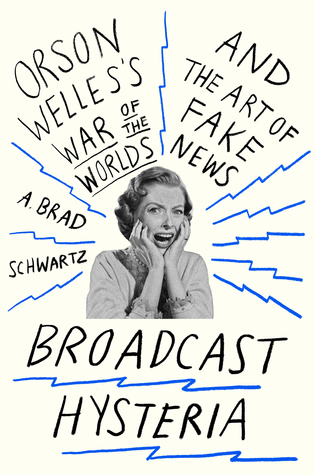 Broadcast Hysteria: Orson Welles's War of the Worlds and the Art of Fake News by
Broadcast Hysteria: Orson Welles's War of the Worlds and the Art of Fake News by 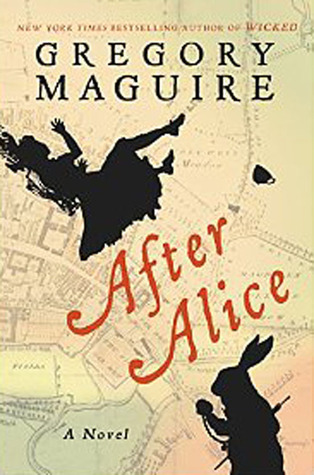 After Alice by
After Alice by 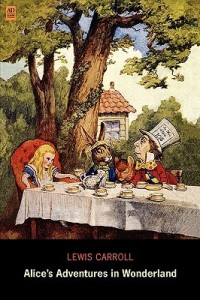 Alice’s Adventures in Wonderland
Alice’s Adventures in Wonderland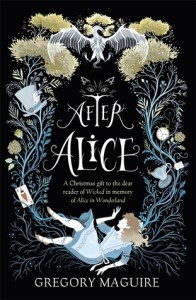 Like Alice’s own journey, Ada’s contains a surprising amount of commentary into her time and place, disguised in the nonsensical, but not actually nonsense, journey through Wonderland.
Like Alice’s own journey, Ada’s contains a surprising amount of commentary into her time and place, disguised in the nonsensical, but not actually nonsense, journey through Wonderland.
 Scandal Takes the Stage (The Wicked Quills of London, #2) by
Scandal Takes the Stage (The Wicked Quills of London, #2) by 









 Cruz (Hell Squad #2) by
Cruz (Hell Squad #2) by 
 The Lodge on Holly Road (Life in Icicle Falls, #6) by
The Lodge on Holly Road (Life in Icicle Falls, #6) by 
 Damage Control (Valiant Knox #2) by
Damage Control (Valiant Knox #2) by 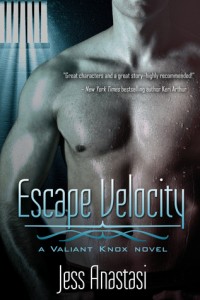 The CSS still strikes this reader as basic fundamentalist-type loonies, but they seem to be damn effective loonies. If space opera with a very strong romantic element is your thing, start with
The CSS still strikes this reader as basic fundamentalist-type loonies, but they seem to be damn effective loonies. If space opera with a very strong romantic element is your thing, start with 

 Current Giveaways:
Current Giveaways: Blog Recap:
Blog Recap: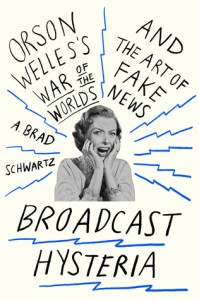 Coming Next Week:
Coming Next Week:






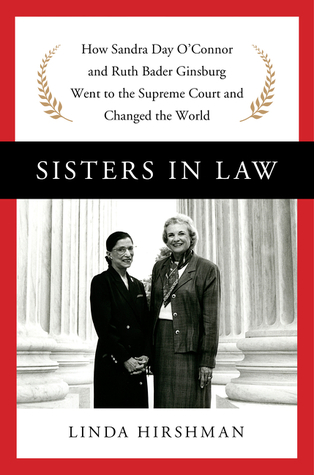 Sisters in Law: Sandra Day O'Connor, Ruth Bader Ginsburg, and the Friendship That Changed Everything by
Sisters in Law: Sandra Day O'Connor, Ruth Bader Ginsburg, and the Friendship That Changed Everything by